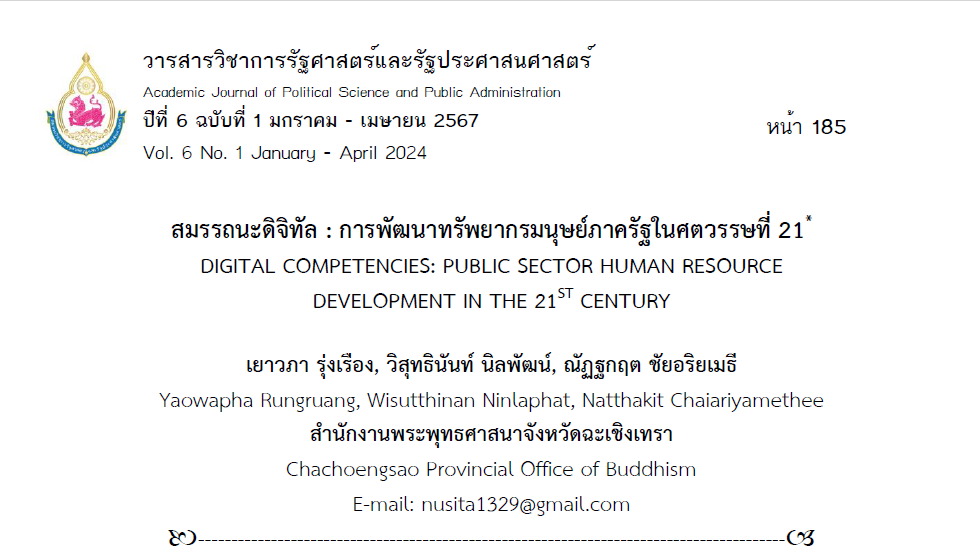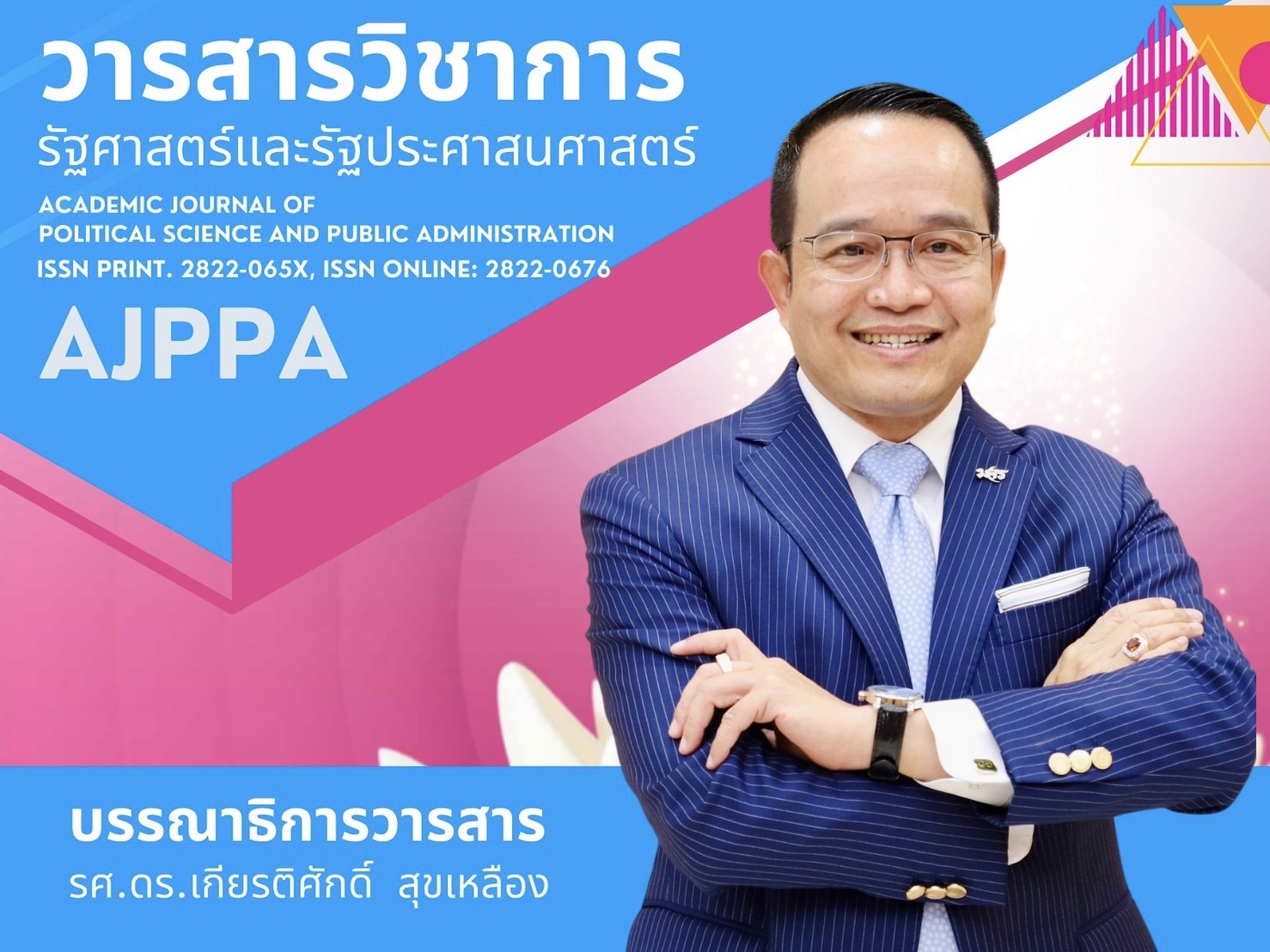DIGITAL COMPETENCIES: PUBLIC SECTOR HUMAN RESOURCE DEVELOPMENT IN THE 21ST CENTURY
Keywords:
Digital Competency, Human Resource Development, 21 CenturiesAbstract
The necessary digital competency framework towards human resources development of public sector organizations in the 21st century. From the review of concepts, the digital competency approach had been summarized into 4 parts and had integrated competency units into each component as follows: Together with Digital Literacy (D1), Digital Understanding, Digital Skill (D2), Using Digital, Problem Solving Digital (D3), Solving Problems with Digital Tools, and Adaptive Digital (D4). Adapting to digital transformation All of these were elements for promoting application in government organizations to develop human resources in the areas of 1. Training & Learning 2. Promoting between individuals or the ability to work as a team. Teamwork and 3. Evaluation, all things were connected to the development of government resources as a never-ending process. It promoted competency from the beginning into work. until the end or growth in one's career, Safety in the use of digital technology must also be considered appropriately. Organizations must develop digital competencies for government personnel continuously and fairly. Equal for all age groups, every work group because the human resources in each organization and the potential of each department were different. Leaders must promote and push personnel equally to be able to work using digital technology to respond to needs of people and society appropriately in the digital age. Personnel must understand, use and be able to integrate work appropriately based on safety in the use of personal and collective digital, beneficial to the continuous development of oneself and the organization, creating capabilities that are appropriately up to date with the social situation.
References
จิระพงค์ เรืองกุล. (2555). แนวทางการพัฒนาทรัพยากรมนุษย์โดยใช้หลักสมรรถนะประสบการณ์จากบริษัทชั้นนำ. วารสารวิทยาการจัดการ, 29(2), 111-127.
จุฬารัตน์ บุษบงก์. (2566). สมรรถนะดิจิทัล ทักษะเพื่อการเรียนรู้อย่างยั่งยืน ตามเป้าหมายของการประชุมเอเปคด้านการศึกษา 2020. วารสารเทคโนโลยีและสื่อสารการศึกษา, 18(24), 70-85.
ฉัตรณรงค์ศักดิ์ สุธรรมดี และคณะ. (2560). การประยุกต์ใช้สมรรถนะ เพื่อพัฒนาทรัพยากรมนุษย์. วารสารมหาวิทยาลัยราชภัฏร้อยเอ็ด, 11(1), 262-269.
ทศพร พีสะระ. (2566). สมรรถนะกับการพัฒนาทรัพยากรมนุษย์ในยุคการเปลี่ยนแปลง. วารสารวิจยวิชาการ, 6(3), 341-358.
เทพศักดิ์ บุณยรัตพันธุ์. (2566). การจัดการสมรรถนะด้านดิจิทัลของทรัพยากรมนุษย์กับการออกแบบรูปแบบการทำงานเป็นทีมที่มีความคล่องตัวสูง : ความท้าทายขององค์กรในยุคดิจิทัล. วารสารสังคมศาสตร์ นิติรัฐศาสตร์, 7(1), 1-33.
ธัญญารัตน์ พรหมสุทธิ์ และคณะ. (2564). การพัฒนาสมรรุนะทรัพยากรมนุษย์เพื่อรองรับยุคประเทศไทย 4.0. วารสารวิทยาลัยสงฆ์นครลำปาง, 10(1), 228-243.
พสุธิดา ตันตราจิณ และคณะ. (2559). ทุนมนุษย์ : การพัฒนาทรัพยากรมนุษย์ในศตวรรษที่ 21. วารสารสุทธิปริทัศน์, 30(พิเศษ), 115-123.
ศิริรัตน์ พิริยธนาลัย และจุฑา เทพหัสดิน ณ อยุธยา. (2553). Competency สมรรถนะ เข้าใจ ใช้เป็น เห็นผล. กรุงเทพฯ: ซิกเนเจอร์ โซลูชั่นส์.
สำนักงานคณะกรรมการข้าราชการพลเรือน. (2562). ทักษะด้านดิจิทัลที่จำเป็นสำหรับข้าราชการและบุคลากรภาครัฐเพื่อปรับเปลี่ยนเป็นรัฐบาลดิจิทัล. มปท.
________. (2552). คู่มือสมรรถนะหลัก : คำอธิบายและตัวอย่างพฤติกรรมบ่งชี้. กรุงเทพฯ: พี.เอ.ลีฟวิ่ง.จำกัด.
สำนักงานคณะกรรมการดิจิทัลเพื่อเศรษฐกิจและสังคมแห่งชาติ กระทรวงดิจิทัลเพื่อเศรษฐกิจและสังคม. (2563). กรอบสมรรถนะด้านดิจิทัลสำหรับพลเมืองไทย. กรุงเทพฯ: สำนักงานคณะกรรมการดิจิทัลเพื่อเศรษฐกิจและสังคมแห่งชาติ.
________. (2563) แผนพัฒนาความรู้ความเข้าใจประเทศไทย. กรุงเทพฯ: สำนักงานคณะกรรมการดิจิทัลเพื่อเศรษฐกิจและสังคมแห่งชาติ.

Downloads
Published
How to Cite
Issue
Section
Categories
License
Copyright (c) 2024 Academic Journal of Political Science and Public Administration

This work is licensed under a Creative Commons Attribution-NonCommercial-NoDerivatives 4.0 International License.




